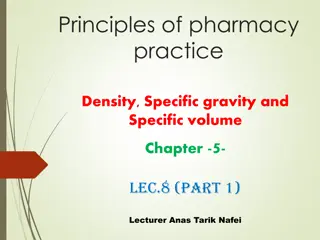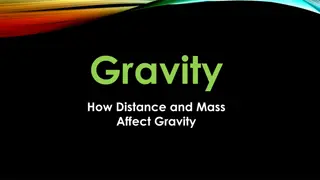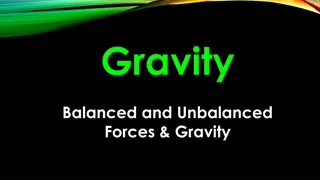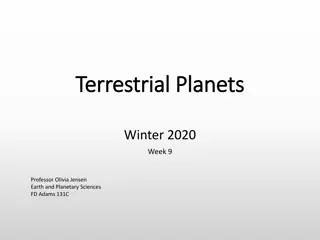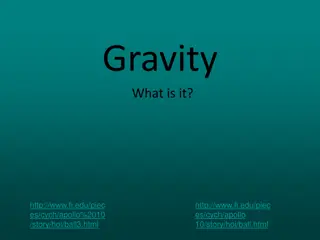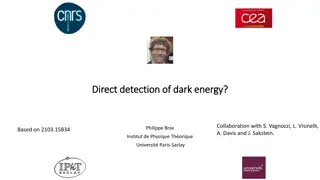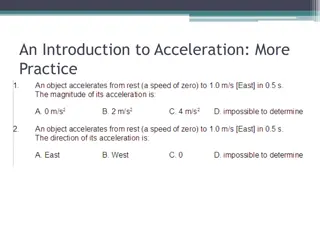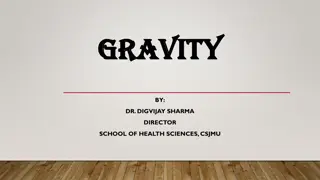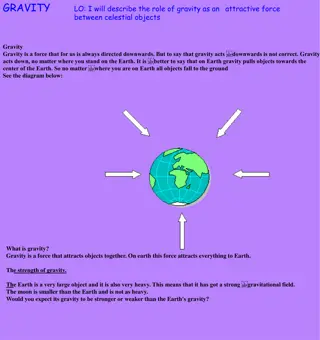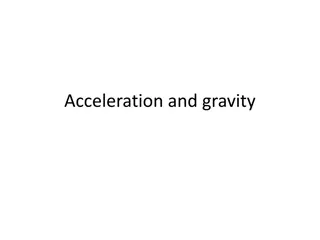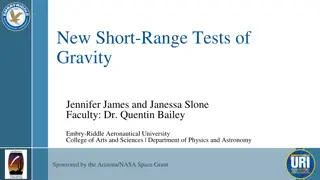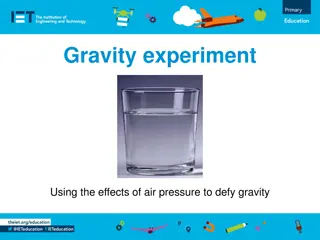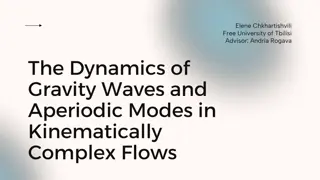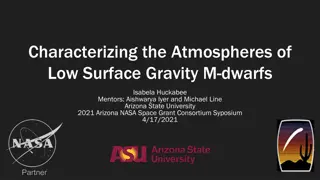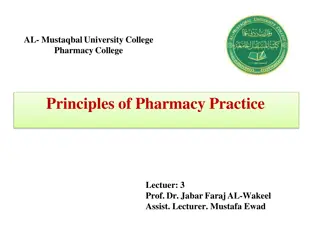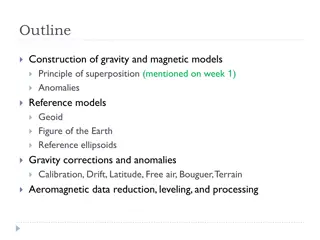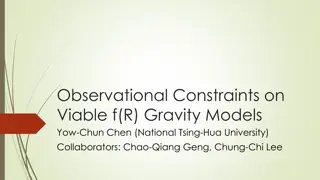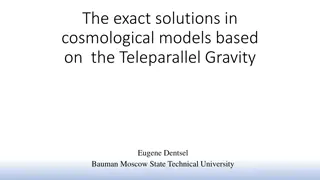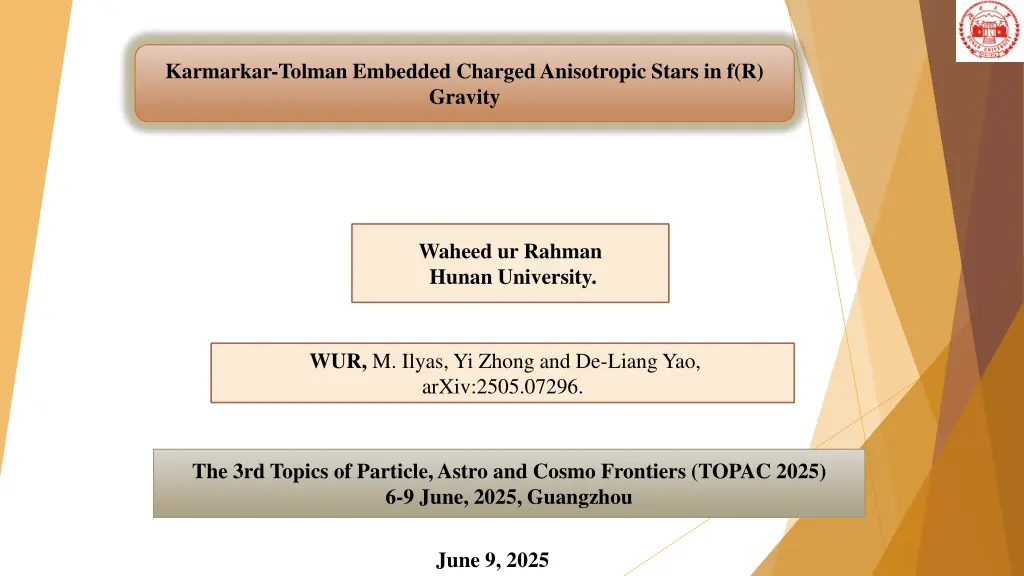
Charged Anisotropic Stars in f(R) Gravity: Exploring New Frontiers
Delve into the intriguing realm of f(R) gravity through the study of charged anisotropic stars embedded within Karmarkar-Tolman spacetime. This research, conducted by Waheed ur Rahman and team at Hunan University, uncovers the complexities of gravitational collapse, cosmic expansion, and more. Discover the advantages of f(R) theory over traditional models, shedding light on the geometric interpretation of gravity and the quest for a comprehensive understanding of the universe's workings.
Uploaded on | 0 Views
Download Presentation

Please find below an Image/Link to download the presentation.
The content on the website is provided AS IS for your information and personal use only. It may not be sold, licensed, or shared on other websites without obtaining consent from the author. If you encounter any issues during the download, it is possible that the publisher has removed the file from their server.
You are allowed to download the files provided on this website for personal or commercial use, subject to the condition that they are used lawfully. All files are the property of their respective owners.
The content on the website is provided AS IS for your information and personal use only. It may not be sold, licensed, or shared on other websites without obtaining consent from the author.
E N D
Presentation Transcript
Karmarkar-Tolman Embedded Charged Anisotropic Stars in f(R) Gravity Waheed ur Rahman Hunan University. WUR, M. Ilyas, Yi Zhong and De-Liang Yao, arXiv:2505.07296. The 3rd Topics of Particle, Astro and Cosmo Frontiers (TOPAC 2025) 6-9 June, 2025, Guangzhou June 9, 2025
Contents Introduction Theoretical Framework Different f(R) gravity models Numerical result and Discussion Summary and Conclusion 2
General Theory of Relativity Einstein Field Equation Matter tells space-time how to curve and space-time tells matter how to move, [1] 1 2 8 G = R g R T 4 C Scalar tensor Ricci tensor Stress energy tensor Metric tensor This equation play a significant role to demonstrate astrophysical aspects like gravitational collapse, big-bang and expansion of the universe. 3
Advantage of General Theory of Relativity General relativity applies to all observers, while special relativity applies only to non- accelerated observers. The theory of relativity explains the behavior of objects in space and time. To predict things such as the existence of black holes, light bending due to gravity and the behavior of planets in their orbits. 4
f(R) theory of gravity The Lagrangian in the Einstein Hilbert action,[2] R is the Ricci scalar to become a general function of R,[3] The general series expansion of f(R) The first term is like the cosmological constant and must be small. The next coefficient a1can be set to one as in general relativity. 5
Advantages of f(R) Gravity Over Other Modified Theories Feature f(R) Gravity Other ModifiedTheories Relatively simple extension of GR, involving only the Ricci scalar R. Theories like Gauss-Bonnet or involve higher curvature terms or extra dimensions. Mathematical Simplicity Adds only one additional scalar degree of freedom. Scalar tensor or vector tensor theories introduce more fields and complications. Degrees of Freedom Easily mapped to scalar tensor theory via a conformal transformation to Einstein frame. Conformal Transformation Some theories (like massive gravity) do not admit such simplification. Keeps the purely geometric interpretation of gravity (unlike MOND which is phenomenological). MOND and TeVeS lack a covariant geometric formulation. Geometric Interpretation 6
Motivation Behind f(R) Gravity But after all, there are the problems with GR too? GR is simple, beautiful.. but seems to be not self-consistent at all scales: cosmological constant Inflation Dark Matter + Dark Energy Quantum Gravity problem Today observations say that there is too few matter in the Universe! hence the need, in order to explain GR, for dark energy and dark matter 7
Possible Modification, either modifying geometrical part or adding some additional source terms. Dark Energy and Extended theories of Gravity Cosmological constant ( ) Time varing QFT on curved spacetimes Scalar field theories String/M-theory corrections Phantom fields Brane-world models Phenomenological Theories Exotic matter We will focus some of the cosmological aspects of the extended theories of gravity 8
Spherical anisotropic fluids and f(R) gravity The Modified f (R) Gravitational Theory The following modified equations in the field are obtained by varying the operation with respect to the yields of the metric-tensor Where partial derivatives are ,with respect to R ?? is the fluid of four velocity and ????= 1 and ????= 1. where 9 ??
Matter distribution For dynamical spherical symmetric geometry is [4] where a and b are the functions of radial coordinate and we assume A, B and C are arbitrary constants that can be determined using physical conditions. 10
Conti where the Ricci scalar R is using the definition of a and b With the help of these equations, we developed the theoretical modeling of compactgeometries, where the values of constants A, B, and C 12
Electric Charge where Bg represents the bag constant 14
Matching With Reissner-Nordstrm Exterior Metric [5,6] The estimated quantities of masses M , radii R, and constants A, B and C, of the Three compact star 15
Different models We used some of the realistic models for studying anisotropic charge compact star. Model 1 where is constants Model 2 where and are constant Model 3 where and are constant Here we assume the value = 0.03 and = 0.5 for the three different gravitational models 16
Energy density and pressure evolutions The action of energy density, anisotropic stresses, and their radial derivative for each compact star Using the numerical values of constant A , B and C into the field equations along with the suggested three related models as r 0 the energy density goes to maximum. For compact stars under three different viable models, This is to be expected since these are diminishing functions, and we have a maximum density for small r e.g. star core density c = (0). 17
Physical Aspects of f(R) models The energy density, radial and transverse pressure variation of strange compact stars candidate, HerX 1, SAX J 1808.4 3658 and 4U 1820 30, under three different viable models. 18
Energy Conditions For the mathematical expressions of the stress-energy tensors to represent physically acceptable matter fields, they should obey some particular constraints, widely known as Energy Conditions. [10] 19
TolmanOppenheimerVolkoff (TOV) equation It can also be expressed in terms of gravitational , hydrostatic, anisotropic and electromagnetic forces, The variation of gravitational force (Fg), hydrostatic force (Fh ) , anisotropic force (Fa ) and electromagnetic force (Fe)with respect to the radial coordinate r (km). 21
Stability-Scenario We look the stability of Charge compact star models under viable models in the f (R) theory. To test our model stability, we measure the radial and transverse speeds as follows: For stability, the radial as well as the transverse speed should obey the condition [0, 1] and [0, 1]. 2 2 ??? ??? 22 So the stability is attained for charge compact stars in the f (R) gravity models.
Electric charge and charge density Radial distribution of the charge function Q(r), derived from Gauss s law in curved spacetime, illustrating the accumulation of charge within the stellar interior. Charge density as a function of the radial coordinate r , illustrating the spatial distribution of charge in the star. 23
Electric Field Squared electric field as a function of radial distance, demonstrating the role of charge in maintaining the stability of the compact star. 24
Anisotropic Component We get > 0 while plotting the anisotropy, e.g. anisotropy is oriented outward which indicates that the metric of ??> ?? The variations of anisotropic measure against the radial coordinate, r (km). 25
Benefits of Our Work and Motivation The motivation behind our study lies in the growing interest in modified gravity theories, particularly f(R) gravity the Karmarkar-Tolman embedding technique offers a systematic way to construct physically realistic stellar models. Our study fills this gap by integrating the Karmarkar-Tolman condition within the f(R) gravity framework, leading to new and physically meaningful exact solutions. A notable advantage of our study is the detailed analysis of structural properties through graphical methods, which enhances the understanding of the physical behavior of these stars under different curvature scenarios. Improvements of Our Study Compared to Previous Literature Use of Karmarkar-Tolman Embedding in f(R) Gravity Comparative Analysis Across Multiple f(R) Models Graphical Validation and Physical Consistency Incorporation of Charge Effects 26
Summary and Conclusion We checked the viability of f (R) gravity models in the physical modeling of Three different charge compact stars. The anisotropic stresses and energy density are positive throughout the star configurations. The r-derivatives of density and anisotropic stresses (i.e. density and pressure gradients) remain negative. All types of energy conditions are valid. The sound speeds remain within the bounds of [0, 1] (i.e., charge compact stars are stable). A strong electric field generates an outward force that counteracts gravitational collapse, thereby contributing to the equilibrium of the system. The charge distribution Q(r), determined using Gauss s law in curved spacetime The measure of anisotropy remains positive at the star core. 27
References [1] ] R. C. Tolman, Static solutions of Einstein s field equations for spheres of fluid, Phys. Rev. 55, 364 (1939). [2] J. R. Oppenheimer and G. M. Volkoff, On massive neutron cores, Phys. Rev. 55, 374 (1939). [3] W. Baade and F. Zwicky, Remarks on Super-Novae and Cosmic Rays, Phys. Rev. 46, 76 (1934). [4] R. L. Bowers and E. P. T. Liang, Anisotropic Spheres in General Relativity, Astrophys. J. 188, 657(1974). [5] S. Capozziello and M. De Laurentis, Extended theories of gravity, Phys. Rep. 509(4-5) (2011) 167 321. [6] M. Ruderman, Pulsars: structure and dynamics, Ann. Rev. Astron. Astrophys. 10, 427 (1972). [7] A. R. Athar, M. Ilyas, and B. Masud, Anisotropic strange compact stars in Krori-Barua spacetime under f (R, G) gravity, Int. J. Geom. Meth. Mod. Phys. 20, 2350003 (2023). [8] A. Qadir, K. Y. Kim, and H. W. Lee, Modified relativistic dynamics, Int. J. Mod. Phys. D 26, 1741001(2017). [9] S. Nojiri and S. D. Odintsov, Modified Gauss-Bonnet theory as gravitational alternative for dark energy,Phys. Lett. B 631, 1 (2005), arXiv:hep-th/0508049. [10] S. Capozziello, S. Nojiri, and S. D. Odintsov, Unified phantom cosmology: Inflation, dark energy and dark matter under the same standard, Phys. Lett. B 632, 597 (2006), arXiv:hep-th/0507182. [11] S. Capozziello and M. De Laurentis, Extended Theories of Gravity, Phys. Rept. 509, 167 (2011). 28



